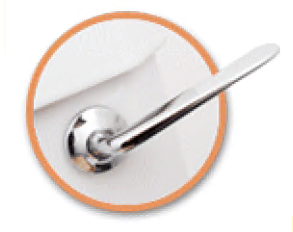Water Conservation Tips Archive
10/1/24
While you are waiting for the tap water to heat up, catch it in a container! You can use this water for several purposes such as watering your plants or rinsing off dishes.
4/1/24
Watering your garden
Water your garden in the early morning or in the evening to achieve the best irrigation.
10/1/23
Monitor your water meter
Are you aware there is a way to monitor your water meter? There are devices compatible with you Neptune meter that are able to find water leaks before they cause damage. You can monitor your use in real-time to reduce waste! There is a smarter way to track and reduce your water use.
7/1/23
Dirty Sidewalks and Driveways
Use a broom to clean driveways, sidewalks and steps.
Using a hose wastes hundreds and hundreds of gallons of water.
10/1/22
Toilet with a 1 and 2 Button!
It is for Water Conservation! The larger lever is to flush out around 1.5 to 2 gallons of water, whereas the smaller lever is to flush out 3/4 to 1 gallon of water. Clearly, the larger one is to flush solid waste and the smaller is to flush liquid waste.
7/1/22
Rain Garden
Have you heard of a rain garden? It’s easy to install, looks good year-round and has a positive impact on the environment!
A rain garden is a type of garden, designed to collect stormwater runoff from a roof, driveway or other impervious surfaces. Rather than rushing off into a storm sewer or a local waterway, the rainwater collects in a shallow depression in your yard. This area is planted with native grasses and wildflowers, such as golden rod, monkey flower and switchgrass, that are specially selected for their ability to gradually absorb and filter stormwater.
Rain gardens can have a significant impact on the water quality in our communities. Much of the pollution in streams, rivers and lakes has been carried there by stormwater. By taking responsibility for the rainwater that falls on your own roof and driveway, you’ll be helping to protect our rivers, streams and lakes from stormwater pollution. Adding a rain garden to your yard will also provide food and shelter for wildlife, and give you a whole new garden that’s hardy, low maintenance and naturally beautiful!
(4/1/2022)
Lawn Watering
With spring arriving, water the lawn or garden during the coolest part of the day, early morning is best. Do not water on windy days.
- (1/4/2022)
Here’s a handy trick: check your meter two hours before and after no water is running in the house. If the reading on the meter has moved, it’s because there is a leakage. Call a professional and get it fixed immediately.
- (5/27/2021)
Reuse your cook water!
Boiling water for cooking, making tea, and other kitchen tasks can be a real water waster. Only boil what you need—don’t fill up the pot if it’s not necessary. You can also reuse water used for cooking by letting it cool first and watering plants with it.
- (1/1/2021)
Drinking Water
Keep a container or bottle of drinking water in the fridge. This beats the inefficient tendency for running tap water to cool it for drinking. This could save 200 to 300 gallons every month.
- (10/1/2020)
Laundry
Were you aware that laundry accounts for about 22 percent of all water usage in a household? When doing laundry run full loads and skip the extra rinse. By taking these small steps you will make a positive impact on water conservation!
- (9/3/2020)
Fix That Leak!

Fixing a toilet leak is a great way to reduce household water use
and boost water conservation. It may even reduce your water and sewer costs! If your
toilet has a leak, you could be wasting about 200 gallons of water every day. That
would be like flushing your toilet more than 50 times for no reason! Try this
experiment: test for leaks by placing a drop of food coloring in the toilet tank. If the
color shows up in the bowl without flushing, you have a leak! - (7/1/2020)
Cleaning Produce
Summertime is here and with fresh vegetables and fruits in season, try cleaning your produce in a bowl of clean water rather than cleaning them under a running faucet.
- (4/2/2020)
Scrape – Don’t Rinse!
Before putting your dishes in the dishwasher, scrape — don’t rinse!
Pre-rinsing can use more than 6,000 gallons of water per household every year.
- (1/12/2020)
Have you heard of a Water Pebble?
The water pebble is a small, disc that is placed near the plughole on your shower and measures the amount of water you use. It can also memorize your usage. During the start of your bath, it flashes a green light. The light will start to turn amber when you’re halfway through the acceptable amount of water then switches to red. While this may not make showers fun, it is an ingenious gadget that will help you save a lot of water during your next shower.
- (7/18/2019)
Saving Water During SummerAs summer arrives, average household water consumption
more than doubles, mostly due to landscape irrigation. But you don’t have to forego gardening
to trim outdoor water use. With just a few simple steps, you can reduce your landscape’s water
needs.
Reducing household water usage won’t just preserve existing resources – it will also save you
money. Try these 16 easy ways to save water.
1. Water at the right time
Water landscapes early in the morning, when air is still and evaporation loss minimal.
Conversely, avoid watering on windy days and at midday, when water frequently evaporates
before it can soak into soil. With automatic irrigation systems, always adjust your controller
when the seasons change.
2. Monitor leaks
Check all hose connections for drips. Frequently inspect washers, replacing as needed. Repair
leaky exterior spigots. Many faucet fixes are simple do-it-yourself tasks. Also inspect valves in
automatic irrigation systems for leaks.
3. Collect rain
Create your own water supply by collecting rain runoff. Rain barrels offer fast and easy
installation. A cistern provides large-volume water collection and is often a project you can
tackle yourself. Contact your local Cooperative Extension System office for cistern schematics
and considerations.
4. Reconsider slopes
It’s difficult to irrigate slopes efficiently. Buffer and reduce runoff on grassy slopes by planting
edges with ground covers or shrubs. Native plants are an ideal choice.
5. Know your soil
With automated irrigation, make sure soil is absorbing water – and not permitting runoff. Many
soil types, such as clay or dry desert soil, don’t absorb large amounts of water easily. Use short,
repeated watering cycles to deliver water at a rate soil can absorb. Most irrigation controllers
can be programmed to water in short, repeated intervals. Follow this same technique when
irrigating slopes. Also consider amending soil with organic matter to improve soil’s water holding
capacity.
6. Build basins
Mound soil to form a water collection basin around plants and shrubs. If space permits, extend
the basin to a plant’s dripline.7. Replace lawn
Carefully consider lawn needs. Lawns need twice as much water as beds filled with flowers and
shrubs. Some of the most challenging lawn areas to water efficiently are slopes (see No. 4),
curving areas and narrow swaths under 10 feet. Replace lawn with native plant groupings or
outdoor living areas.
8. Re-use water
Collect household wastewater from dehumidifiers or air conditioning condensers for irrigation.
Use water immediately, or save it in a bucket for future use. Don’t recycle water containing
bleach, fabric softener or automatic dishwashing detergent.
9. Sweep debris
Grab a broom instead of a hose to clean sidewalks, driveways, porches or decks. Sweeping
conserves water (and burns calories).
10. Create zones
Group plants based on water needs to enhance irrigation efficiency. In an existing landscape,
tackle this project over several years by renovating one planting area at a time.
11. Mulch soil
Apply a 2-inch layer of mulch to planting beds to slow water evaporation from soil. Mulch also
helps suppress weeds.
12. Update equipment
Replace and upgrade irrigation equipment, including timers and sprinklers. Look for low
precipitation rate sprinklers, smart controllers, and low-volume micro-irrigation, such as drip
irrigation, soaker hoses, bubbler irrigation and micro-sprinklers. These items water plants
slowly, minimizing evaporation, runoff and overspray. Consider retrofitting landscape sprinklers
to drip irrigation.
13. Dethatch & aerate
Help lawns absorb water efficiently by limiting thatch and aerating on a regular basis.
14. Mow correctly
Mowing at the proper height for summer growing conditions reduces a lawn’s water needs.
15. Sprinkle wisely
Observe sprinklers to make sure they’re working properly. When running a sprinkler, set an
oven timer to ensure you don’t forget to turn the water off.
16. Stop dribbles
Add a shut-off valve to the end of hoses. Turn the valve to the off position when you’re dragging
the hose from place to place. - (5/1/2019)
Household Leaks
According to the EPA, the average household leak wastes 10,000 gallons of water each year. However, 1 in 10 homes waste at least 90 gallons of water each day in leaks. A leaky faucet dripping one drop per second can waste more than 3,000 gallons a year, and a leaky shower with 10 drips per minute can waste over 500 gallons of water per year. The average leaky toilet can waste about 72,000 gallons of water per year. Finding and fixing these leaks can save you 10% on your water bill.
To check for a leaky toilet, place a few drops of food coloring in the toilet tank and see if it spreads into the bowl within a half-hour. If it does, that means a leak is present and gallons of water may be being wasted.
Water conservation efforts can help the homeowner save a little money while benefiting the planet as well.


